Discover the Best Board Games for Every Player

Family Ties: Games That Bring Everyone Closer Together
Board games are a fantastic way to connect with family across generations. They spark conversations, encourage teamwork, and create lasting memories. This guide highlights 10 family-friendly games that cater to various age groups, skill levels, and play styles. Whether you're looking for quick fun, strategic challenges, or cooperative problem-solving, there's something here for everyone.
Top Picks:
- Ticket to Ride: Simple yet strategic, perfect for ages 8+ with a playtime of 30–60 minutes.
- Quacks of Quedlinburg: A risk-and-reward potion-making game for ages 10+, lasting about 45 minutes.
- Castle Panic: A fully cooperative tower defense game for ages 10+ with a 60-minute playtime.
- Mysterium: A creative mystery-solving game for ages 10+, taking around 42–60 minutes.
- Creature Comforts: A gentle, nature-themed game for ages 8+, lasting 45–75 minutes.
- Bananagrams: A fast-paced word game for ages 7+, with rounds lasting just 10–20 minutes.
- Kingdomino: A quick tile-laying game for ages 8+, with 15–20 minute rounds.
- Barenpark: A bear-themed puzzle game for ages 8+, lasting 30–45 minutes.
- Quest for El Dorado: A deck-building adventure for ages 10+, with a playtime of 30–60 minutes.
- Planet Unknown: A space-themed strategy game for ages 10+, lasting 60–80 minutes.
Quick Comparison:
| Game | Age Range | Style | Playtime | Players |
|---|---|---|---|---|
| Ticket to Ride | 8+ | Light Competition | 30–60 min | 2–5 |
| Quacks | 10+ | Risk & Reward | 45 min | 2–4 |
| Castle Panic | 10+ | Cooperative | 60 min | 1–6 |
| Mysterium | 10+ | Mystery/Cooperative | 42–60 min | 2–7 |
| Creature Comforts | 8+ | Light Competition | 45–75 min | 1–5 |
| Bananagrams | 7+ | Word Game | 10–20 min | 1–8 |
| Kingdomino | 8+ | Tile-Laying | 15–20 min | 2–4 |
| Barenpark | 8+ | Puzzle | 30–45 min | 2–4 |
| Quest for El Dorado | 10+ | Deck-Building | 30–60 min | 2–4 |
| Planet Unknown | 10+ | Strategy | 60–80 min | 2–6 |
These games are perfect for creating shared moments of fun and connection. Whether you're defending a castle, racing to El Dorado, or solving mysteries, each offers a unique way to bring your family closer together.
Best Family Board Games | Our Top 10s
What Makes a Great Family Board Game?
Not every board game brings families together in the same way. The best family board games have certain qualities that make them enjoyable, easy to play, and memorable for everyone, no matter their age. So, what exactly makes a board game a family favorite? Let’s break it down.
Flexible player count is a must. A great family game can accommodate anywhere from 2 to 6 players, making it perfect for both small and large gatherings. This way, no one feels left out, and the game still runs smoothly without becoming chaotic.
Another key ingredient is simple rules with depth. Family games should be easy to pick up and explain, but they also need to offer enough strategy to keep adults interested. The goal is to avoid overly complicated mechanics while still providing meaningful choices that engage players of all ages.
The age range is another important factor. Games designed for ages 8 and up (or sometimes 10 and up) ensure that younger players can participate meaningfully, while still offering enough challenge to keep teens and adults entertained.
Playtime matters, too. Games that last between 30 and 90 minutes hit the sweet spot. Shorter games can feel underwhelming, while longer ones risk losing the attention of younger players or being hard to fit into a busy family schedule.
A great family game also encourages interaction and communication. Whether it’s through cooperative teamwork or friendly competition, the best games create moments of laughter, conversation, and shared excitement. These are the moments that turn game night into a cherished family tradition.
For many families, games that mix fun with a bit of learning are especially appealing. Whether it’s geography, history, or problem-solving, parents appreciate games that help kids develop skills while still being entertaining.
Cooperative games can be a big hit, too. Instead of competing against each other, families work together to beat the game itself. This approach fosters teamwork and avoids the hurt feelings that can sometimes come with competitive play.
Let’s not forget visual appeal and quality components. Games with eye-catching designs and durable pieces feel more special and can stand up to years of enthusiastic play.
Finally, the best family games offer replay value. Whether it’s through variable setups, new strategies to explore, or a bit of randomness, these games keep players coming back for more. They’re the ones families reach for again and again, building traditions that last for years.
1. Ticket to Ride
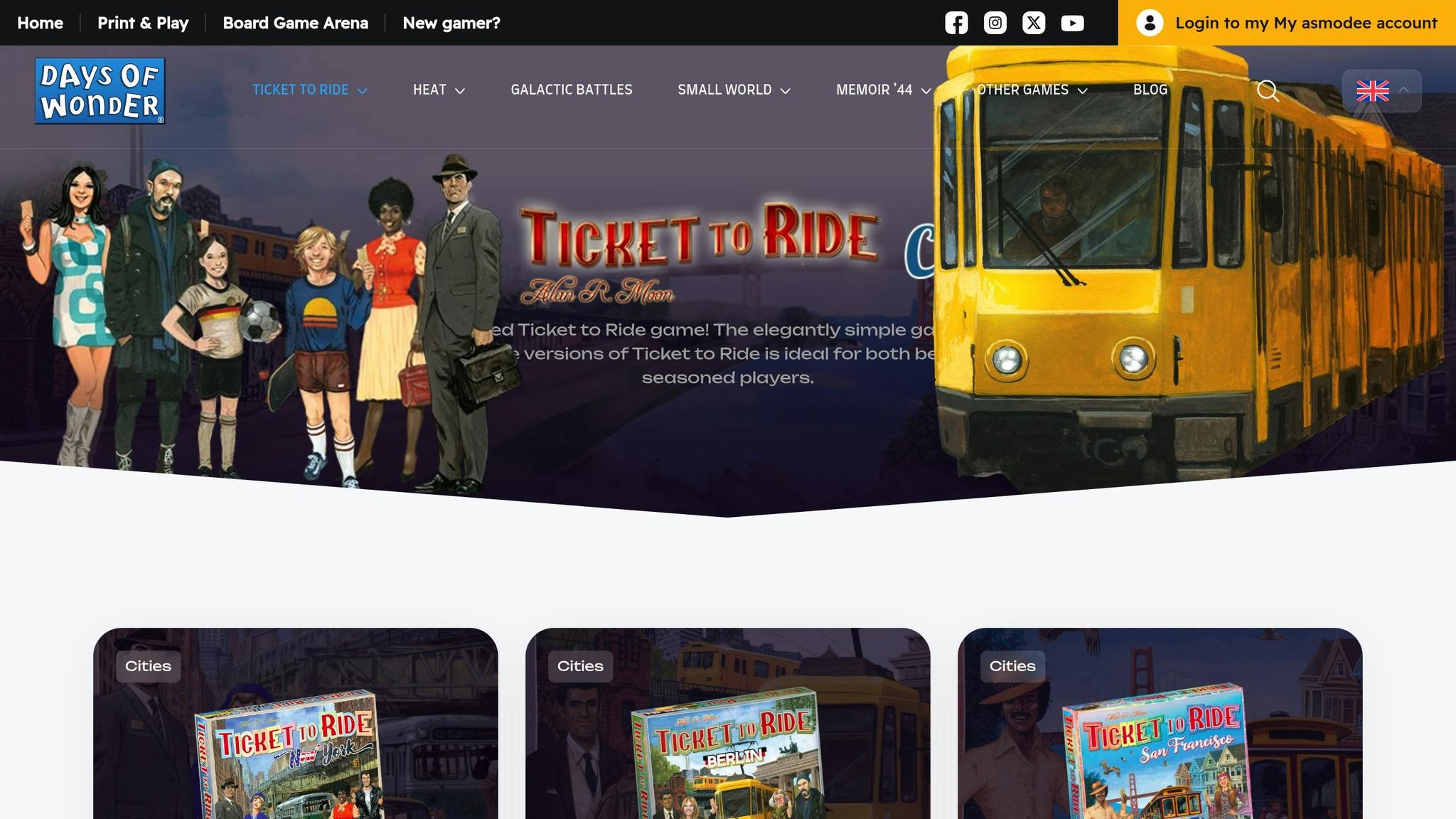
Ticket to Ride strikes a perfect balance between simplicity and strategy, making it a go-to choice for family game nights. The premise is straightforward: players collect colored train cards to claim railway routes connecting cities. At the start, everyone receives destination tickets outlining specific routes to complete for points. As the board fills up with trains, the competition heats up, with players racing to secure their paths. Along the way, conversations often spark about the cities on the map, giving kids a chance to learn geography while adults dive into strategic planning. This mix of fun, learning, and strategy creates unforgettable moments around the table.
Age Compatibility
This game is designed for players aged 8 and up, making it a hit with both younger kids and adults. Elementary-age children can easily grasp the basics - matching colored cards to claim routes - while older players enjoy the deeper strategies, like blocking opponents' plans or scoring big with longer connections. This layered gameplay ensures everyone, from kids to grandparents, stays engaged.
Teamwork vs. Competition Balance
Ticket to Ride leans heavily into friendly competition. Each player focuses on building their own network of routes to complete their destination tickets. On the USA map, the gameplay can get intense, with players strategically blocking each other. For a gentler experience, the Europe map introduces Stations, while the Asia map includes a team-based variant for those who prefer collaboration.
Player Count Flexibility
Whether you have a small family or a full house, Ticket to Ride works. It supports 2 to 5 players, adapting seamlessly to the group size. Smaller games emphasize efficient route planning, while larger groups bring more competition and strategic challenges as the board fills up with trains.
Playtime Duration
With a playtime of 30 to 60 minutes, Ticket to Ride fits perfectly into a family evening. The game moves quickly, keeping everyone engaged from start to finish.
At $49.99, Ticket to Ride offers excellent quality and countless opportunities for replay, making it a worthwhile addition to any family's game collection.
Shop Ticket to Ride at Brain Games
2. Quacks
The Quacks of Quedlinburg brings the world of medieval alchemy to your family game night, where everyone steps into the role of a quack doctor concocting potions. The thrill lies in drawing ingredient chips from your bag and adding them to your pot, all while hoping your brew doesn’t explode. This push-your-luck mechanic creates tense, memorable moments as players weigh the risk of adding just one more ingredient. When a pot inevitably bursts, it’s sure to spark laughter and become a highlight of the game.
The game also features a bag-building element that adds a layer of strategy. As players score points, they can purchase new ingredient chips with special abilities, allowing them to fine-tune their bags. This customization means every family member can develop their own unique brewing style and approach. The mechanics are well-designed to ensure smooth gameplay for all ages.
Age Compatibility
While the game is officially recommended for ages 10 and up, many families find it works just as well for children as young as 8. The core mechanics - drawing chips and adding them to your pot without exceeding a limit - are easy to grasp. One Reddit user shared their experience:
"My 8yo daughter enjoys it, watching her trying to discern her chances of success/failure is entertaining." - I-Am-Only-Me, Reddit User.
For younger players, simplifying the game can make it more approachable. Removing advanced features like rat tails, event cards, or specific potions helps ease them into the rules. Parents often report success with this approach, noting that younger kids can fully engage after a few simplified games. Even children aged 9 and 11 are capable of mastering the game and competing on equal footing with adults.
Teamwork vs. Competition Balance
Quacks strikes a great balance between individual strategy and shared excitement. Each player manages their own pot and bag, but the simultaneous gameplay fosters a sense of togetherness as everyone reacts to the unfolding drama. The rat tail mechanism is particularly family-friendly - it compensates players whose pots explode, keeping them competitive and encouraging risk-taking, especially for younger participants. The role of luck ensures that no one, whether kid or adult, dominates the game too easily.
Player Count Flexibility
Designed for 2 to 4 players, Quacks adapts well to different family sizes. The simultaneous turns mean the game flows smoothly, even with a full table, without adding much to the overall playtime.
Playtime Duration
With a playtime of around 45 minutes, Quacks hits the sweet spot for family gaming. The nine-round structure allows for meaningful strategies to unfold without dragging on, keeping younger players engaged. For families with very young kids or those new to board games, starting with two fewer rounds can make the game more manageable and approachable.
Shop The Quacks of Quedlinburg at Brain Games
3. Castle Panic
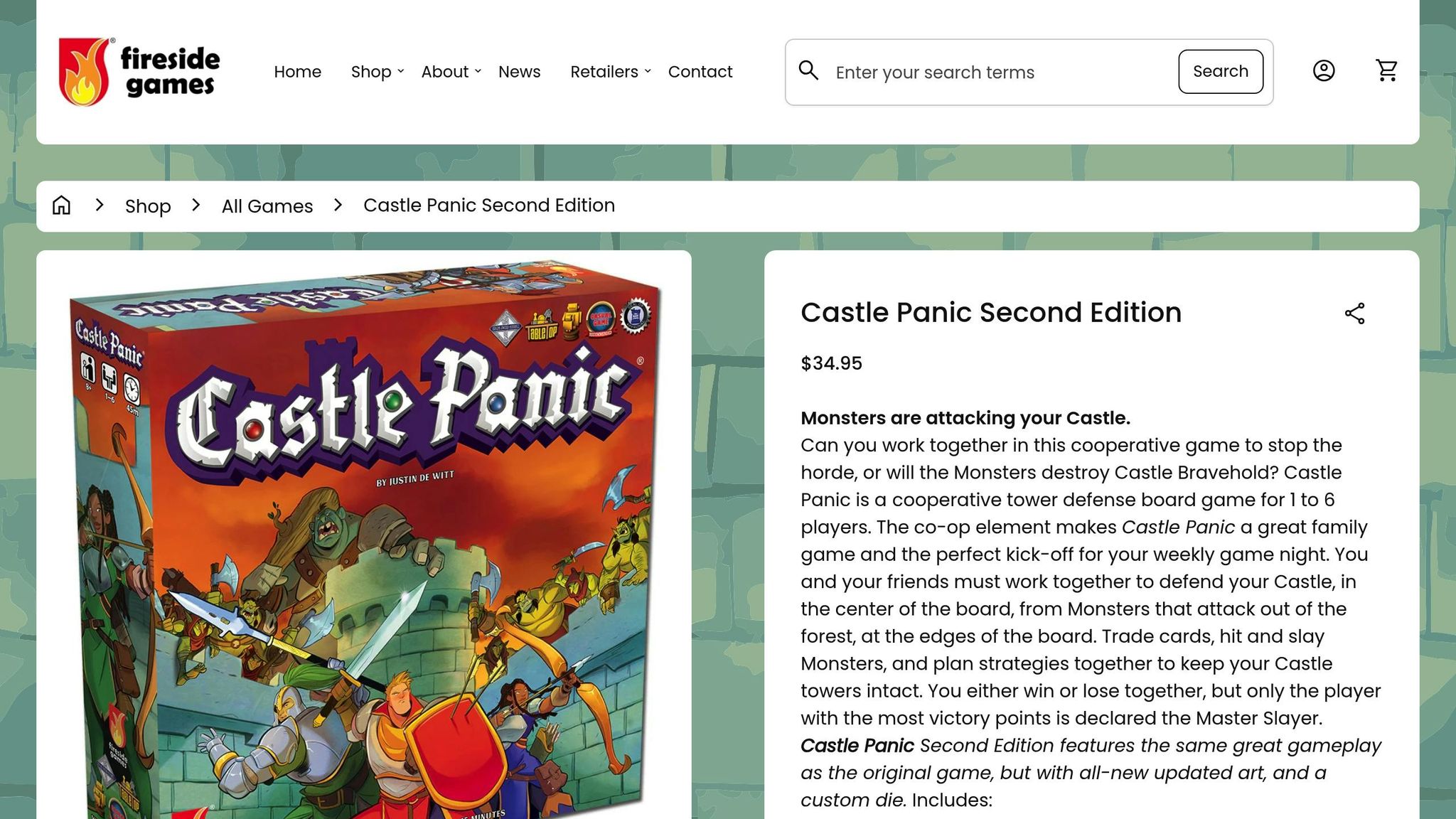
Castle Panic brings families together as they defend a medieval castle from relentless waves of trolls, orcs, and goblins. This cooperative tower defense game encourages communication and teamwork as players strategically use swordsmen, knights, and archers to fend off the advancing monsters.
The game’s card-based mechanics require players to work together, deploying the right units in specific castle rings. This straightforward design ensures that everyone - kids and adults alike - can actively participate in planning and decision-making. The result? A fun and inclusive experience for the whole family.
Age Compatibility
Castle Panic is designed for players aged 10 and up, but its flexible rules make it easy to include younger children. Thanks to its cooperative nature, adults can guide younger players without overshadowing their turns. The clear card symbols, like a sword for the swordsman ring or a bow for the archer ring, make it accessible even for kids who are still learning to read.
To make the game suitable for all ages, the difficulty can be adjusted by adding or removing certain monster tokens. This flexibility not only keeps the gameplay engaging but also ensures that everyone, regardless of age, can work together effectively.
Teamwork Over Competition
What makes Castle Panic stand out is its focus on collaboration. The game is fully cooperative, meaning there’s no room for competitive tension - just shared victories and collective problem-solving. Every win feels like a team accomplishment, and even defeats are met with laughter and a sense of camaraderie. This dynamic naturally fosters discussions and strategic thinking among players.
Flexible Player Count
Whether it’s just you and your child or a larger family gathering, Castle Panic accommodates 1 to 6 players. The game scales seamlessly with the number of participants, ensuring that everyone has a voice in the strategic discussions, no matter the group size.
Playtime That Fits the Family
With an average playtime of around 60 minutes, Castle Panic offers enough time for meaningful collaboration without dragging on. The increasing tension as monsters close in keeps everyone engaged from start to finish. For families with shorter attention spans, you can tweak the game by using fewer monster tokens, reducing the playtime to about 45 minutes.
Shop Castle Panic at Brain Games
4. Mysterium

Mysterium invites players into a world of mystery where teamwork and imagination are key. In this game, one player becomes a ghost, communicating solely through abstract vision cards, while the rest take on the roles of psychics trying to interpret these cryptic clues. The experience is a mix of creativity and collaboration, as players work together to solve the mystery without any verbal hints from the ghost.
The game's stunning artwork and eerie atmosphere pull players into its world, sparking lively debates as they analyze the meaning behind each card. This shared process of decoding and interpreting fosters connection and keeps everyone engaged in the unfolding mystery.
Age Compatibility
Designed for players aged 10 and up, Mysterium can also be adapted for younger children with a few tweaks. For example, families can soften the theme by replacing the murder mystery with a theft or other less intense scenarios. One parent shared how they adjusted the gameplay for their 8-year-old daughter, while another simplified the theme for a 7-year-old nephew. The abstract vision cards make it easy for younger players to participate, encouraging creative thinking and imaginative interpretations.
When playing with kids under 10, adults can step in with gentle guidance to help with more complex clues, ensuring that even the youngest participants feel included and valued during the game.
Teamwork vs. Competition Balance
What makes Mysterium stand out is its semi-cooperative format. Instead of competing against each other, players work together to solve the overarching mystery. Each psychic has their own suspect, location, and weapon to identify, but the shared goal encourages collaboration rather than rivalry.
The voting system adds another layer of teamwork. When a psychic receives a vision, others can vote on whether they agree with the interpretation, earning rewards for accurate predictions. This keeps everyone actively involved and invested in the game, creating a dynamic and inclusive experience for families and groups of all sizes.
Player Count Flexibility
Whether you're hosting a small family game night or a larger gathering, Mysterium adapts beautifully. While it officially supports 2–7 players, it truly shines with 4 or more participants. The voting mechanism becomes more engaging with a larger group, adding depth and excitement to the gameplay.
"It's better with 4 or more. With fewer you lose the voting mechanism which I think really improves the game." – Larry Wooters
Interestingly, some groups have even played with as many as 11 people by having two players share the ghost role, showcasing the game's flexibility and appeal for bigger gatherings.
Playtime Duration
A typical session of Mysterium lasts between 42 and 60 minutes, striking a perfect balance between being immersive and manageable. The pacing allows plenty of time for spirited discussions and debates over the vision cards, ensuring that even if the mystery remains unsolved, the journey is filled with laughter and memorable moments.
5. Creature Comforts

For families who enjoy games with a touch of mystery and strategy, Creature Comforts offers a heartwarming, nature-themed experience that feels both engaging and relaxing.
In this game, woodland creatures prepare for winter through worker placement and resource management, but the tone is far from cutthroat. Instead of fostering tension, Creature Comforts creates a nurturing atmosphere where players focus on seasonal preparation. While technically competitive, the gameplay feels collaborative, making it ideal for families seeking a more gentle gaming experience.
The charm of Creature Comforts lies in its seasonal artwork and gentle competition. The beautifully illustrated scenes of animals gathering supplies and staying warm set the tone for a cozy adventure. Players use a dice drafting system to assign their animal workers to various tasks, but the decisions feel more like thoughtful planning than high-stakes strategy.
What makes this game stand out is its comfort system, which emphasizes keeping creatures warm and well-fed. This thoughtful mechanic encourages players to care for their woodland community, sparking natural conversations about preparation, seasonal changes, and the importance of looking after one another.
Age Compatibility
Designed for ages 8 and up, Creature Comforts is accessible to younger players while still offering enough depth to keep adults engaged. The dice drafting system is simple enough for kids to pick up quickly, and the game's comfort tokens and improvement cards provide clear visual cues to guide their choices.
Parents often find that children are drawn to the nurturing aspects of the game - enjoying the process of keeping their creatures cozy and well-prepared for winter. With minimal guidance, younger players can fully participate, making it a great choice for mixed-age groups.
Teamwork vs. Competition Balance
While Creature Comforts is technically a competitive game, it feels inherently cooperative. There’s no direct conflict or aggressive moves like blocking or attacking. Instead, the competition revolves around who can best prepare their woodland creatures for the challenges ahead.
The dice drafting mechanic introduces strategic choices without creating hard feelings. If someone takes the dice you wanted, it feels more like adapting to natural resource limitations rather than being targeted. This softer approach to competition makes the game ideal for families who want strategy without the stress.
The shared seasonal progression also adds a layer of camaraderie - everyone faces the same challenges together, fostering empathy and understanding even as they compete for victory points.
Player Count Flexibility
Whether you’re a small family of two or hosting a larger group, Creature Comforts accommodates 1-5 players with ease. The game adapts seamlessly by adjusting the number of dice and available locations, ensuring a balanced experience regardless of the group size.
With fewer players, there’s more room to execute strategies, while larger groups introduce more dynamic decisions around dice selection and timing. No matter how many are playing, the game retains its cozy, welcoming feel.
Playtime Duration
With a playtime of 45–75 minutes, Creature Comforts strikes a perfect balance between engagement and accessibility. The game’s four-season structure naturally paces the experience, as each season builds toward the challenges of winter.
This gradual progression keeps players invested, as they see their preparations come to life and pay off by the game’s end. It’s the kind of game where conversation flows easily, making it a delightful way to spend an evening with family.
Shop Creature Comforts at Brain Games
6. Bananagrams
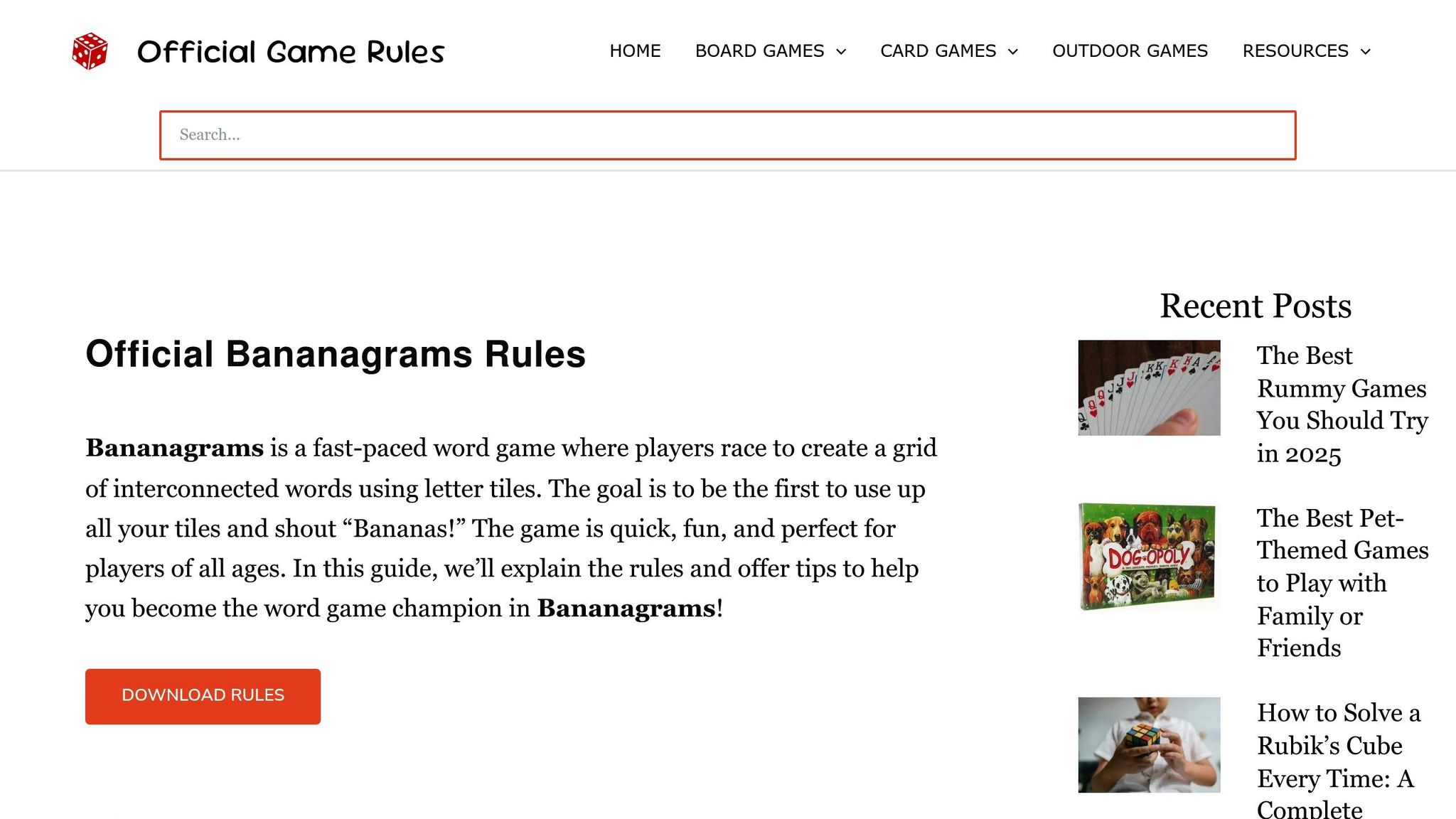
Bananagrams is perfect for families looking to enjoy a quick, engaging word-building game. With its simple setup and fast-paced rounds, it offers a lively way to bring everyone together for some quality time.
This game takes the concept of crossword puzzles and gives it a fresh twist. Instead of waiting for turns, players simultaneously race to build their own word grids using letter tiles. The goal? Use up all your tiles before anyone else!
What sets Bananagrams apart is its inclusive gameplay, making it enjoyable for players of all ages and skill levels. A standout feature is the "Peel" mechanic. Whenever a player uses all their tiles and shouts "Peel!", everyone must draw a new tile and add it to their grid. This shared challenge keeps the game dynamic and fun, sparking laughter and friendly banter along the way. It's a design that ensures everyone can play at their own pace while staying involved.
Age Compatibility
Bananagrams is designed for ages 7 and up, making it a great choice for families with a mix of younger kids, teens, and adults. The rules are simple enough for children to grasp quickly, while still offering a rewarding challenge for older players.
Teamwork vs. Competition
While Bananagrams is competitive by nature, the simultaneous gameplay avoids direct player-to-player conflicts. Even when someone calls "Peel!" and everyone has to grab a new tile, the shared experience often leads to laughter rather than rivalry. This balance creates a lighthearted atmosphere where competition feels fun and supportive.
Flexible Player Count
Whether you're playing with just two people or a group of up to eight, Bananagrams adapts effortlessly. It works just as well for a quiet game between a parent and child as it does for a lively family gathering. The flexibility in player count ensures everyone can join in the fun.
Quick Playtime
With rounds lasting just 10–20 minutes, Bananagrams is perfect for families looking for a quick activity or something to fill the gap between longer games. Plus, the "Best Of" variant allows for multiple rounds, extending the fun for those who want to keep the competition going.
Shop Bananagrams at Brain Games
sbb-itb-1ed942f
7. Kingdomino
Continuing our journey through family-friendly games, Kingdomino brings a unique blend of strategy and creativity to the table. This tile-laying game invites families to build their very own kingdoms, combining the familiar mechanics of dominoes with the fun of designing a royal realm. It’s easy to learn, engaging, and perfect for players of all ages.
In Kingdomino, players select tiles featuring different terrains - like grasslands, forests, or lakes - and use them to expand their kingdoms. Matching these terrains with crowns earns points, and the tile selection system adds an extra layer of strategy. Every choice matters - not just for your kingdom, but also for how it might impact your fellow players. This dynamic keeps the game interactive and fun without causing tension.
Age Compatibility
Designed for players aged 8 and up, Kingdomino is simple enough for younger kids to grasp but still offers enough depth to keep adults entertained. Even children as young as 6 can join in with minimal help, thanks to the game’s intuitive visuals and straightforward rules.
Friendly Competition
While each player focuses on building their own kingdom, the game naturally fosters a collaborative vibe. The tile selection process often sparks conversations about strategy and encourages players to appreciate each other’s creations. The competition is lighthearted and fun, making it perfect for family bonding without any hard feelings.
Quick and Engaging Playtime
With rounds lasting just 15–20 minutes, Kingdomino fits seamlessly into busy family schedules. This short playtime is ideal for younger kids who may not have the patience for longer games, while still offering enough excitement to keep everyone coming back for more.
Flexible for Any Family Size
Whether you’re playing with 2, 3, or 4 players, Kingdomino adapts easily to your group size. It’s great for small family gatherings or larger groups, as the quick rounds allow everyone to take turns or even set up a mini-tournament. Its versatility and fun gameplay make it a fantastic addition to any family game night.
Shop Kingdomino at Brain Games
8. Barenpark
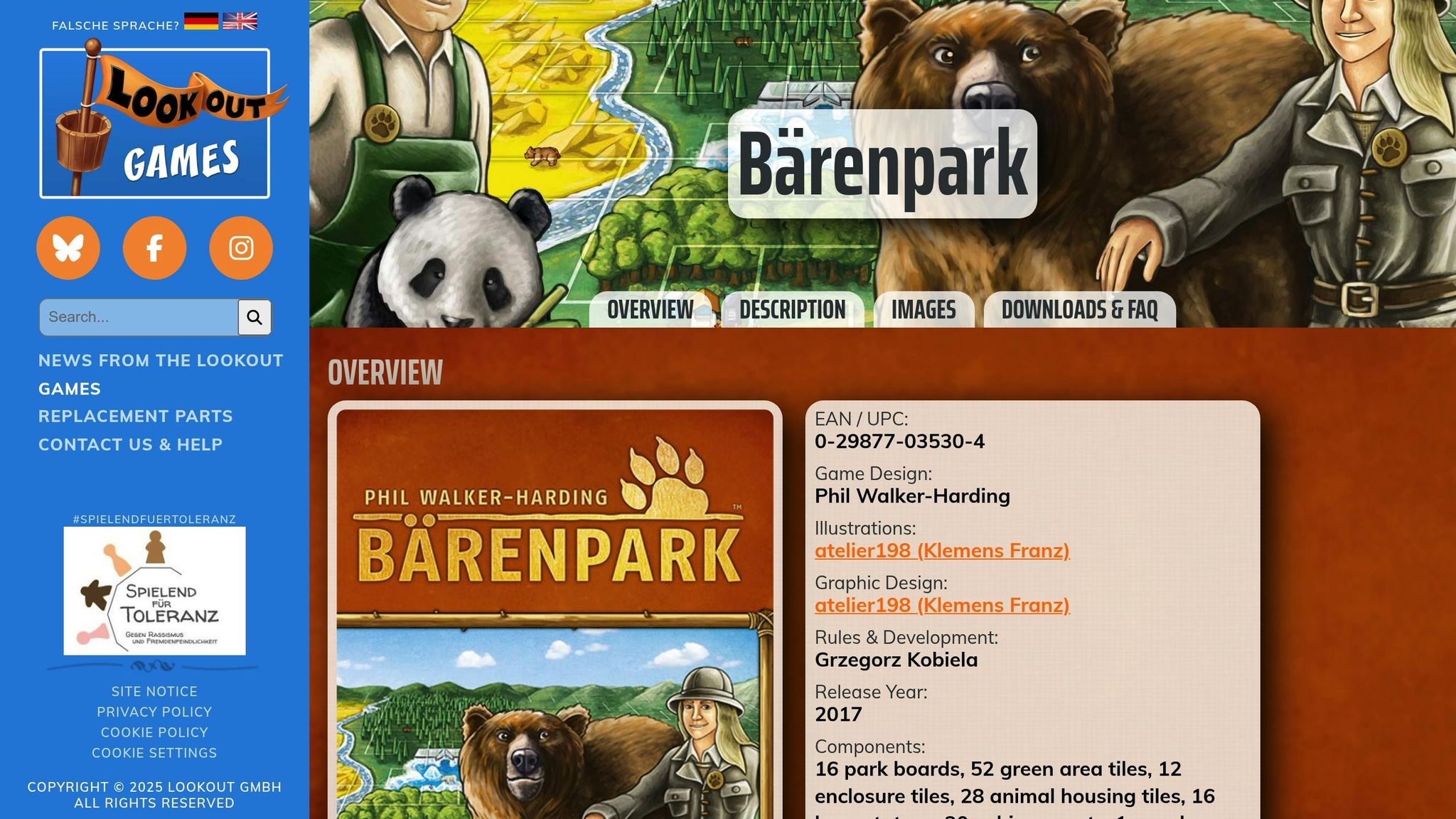
Shifting gears from medieval castles to the world of wildlife conservation, Barenpark invites families to dive into a puzzle-filled adventure focused on designing the ultimate bear park. This tile-laying game blends spatial challenges with adorable bear-themed artwork, making it a hit with both kids and adults. Players take on the role of park planners, piecing together polyomino tiles (think Tetris) to create a thriving bear sanctuary, complete with enclosures and visitor attractions.
The gameplay centers around strategically placing tiles to fill your park boards as efficiently as possible. Each tile represents a unique aspect of the park, like polar bear habitats or snack stands, and completing sections unlocks new tiles and achievements. The puzzle mechanics deliver moments of satisfaction as pieces click into place, while the bear theme adds a cheerful, family-friendly vibe. It's the perfect mix of fun and strategy for a family game night.
Age Compatibility
Barenpark is designed for players aged 8 and up, but its visual and tactile nature makes it approachable for younger kids, around 6, with a little help. The spatial reasoning puzzles are great for developing problem-solving skills, and the whimsical bear illustrations hold the attention of younger players. Meanwhile, adults can appreciate the strategic depth of tile placement and efficiency, making it a game that truly spans generations.
Teamwork vs. Competition Balance
Although Barenpark is a competitive game where each player builds their own park, the competition remains light and encouraging. Players often share tips or admire each other’s clever moves, creating a positive atmosphere. The simultaneous play ensures everyone stays engaged, and the focus on personal achievements rather than direct confrontation keeps the experience enjoyable and family-friendly.
Playtime Duration
With a playtime of 30-45 minutes and room for 2-4 players, Barenpark fits seamlessly into family game nights. The game maintains a steady pace as players work to complete their park sections, avoiding the slowdowns that can sometimes plague longer games. It’s just the right length to keep everyone entertained from start to finish.
Player Count Flexibility
Whether it’s a cozy game night with two players or a lively gathering with four, Barenpark handles different group sizes with ease. The individual park-building focus ensures that the gameplay remains consistent and enjoyable, regardless of the number of players. This flexibility makes it a great choice for families of all sizes, adapting effortlessly to who’s available to play.
9. Quest for El Dorado
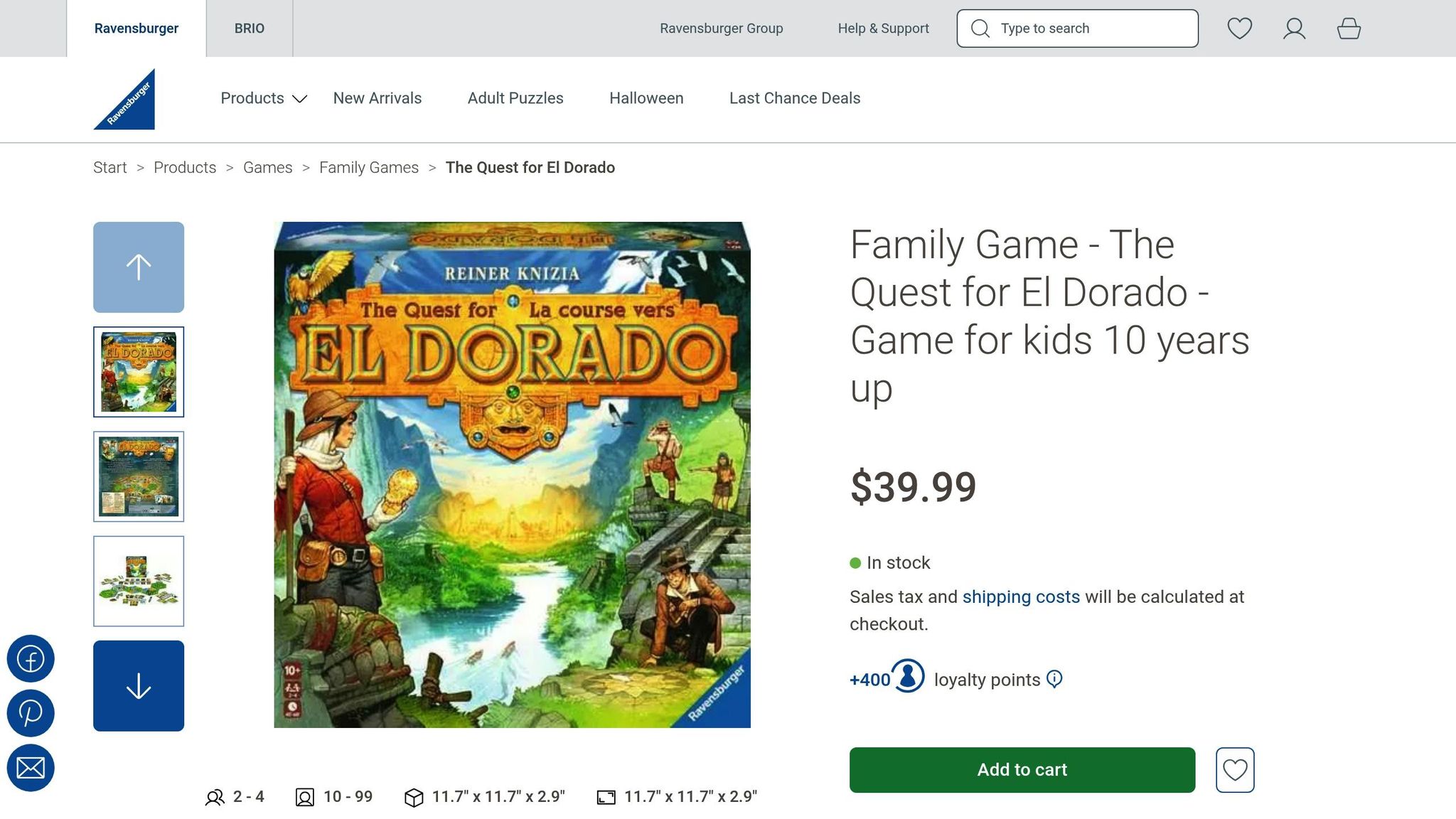
Quest for El Dorado turns family game night into an exciting deck-building adventure. Players step into the shoes of expedition leaders, racing across a modular board toward the legendary golden city. The game's blend of strategic card management and dynamic board layouts ensures every playthrough feels fresh and engaging.
The core gameplay revolves around using cards in two key ways: acquiring better ones from the marketplace or advancing along your chosen route. Each card plays a dual role, letting you strengthen your deck while making progress on the board. Thanks to its modular setup, no two games are ever the same. With a complexity rating of 1.94 on BoardGameGeek, it strikes a great balance between being easy to learn and offering enough depth to keep everyone invested.
"The Quest for El Dorado is more than just a board game; it's an adventure that brings families together. Its deck-building mechanics and exploration theme offer strategic depth for both kids and adults."
Age Compatibility
Designed for players aged 10 and up, Quest for El Dorado is accessible to both younger and older audiences. Its clear objectives and straightforward mechanics make it easy for kids to pick up, while its strategic depth ensures adults stay engaged. The adventurous theme sparks imaginations, making it a hit across generations.
Teamwork vs. Competition Balance
While the game is a race to the finish, it fosters a friendly atmosphere by encouraging players to focus on their own strategies rather than directly sabotaging others. This balance of competition and camaraderie creates a fun, low-pressure environment that strengthens connections during play. It’s a perfect choice for family game nights.
Playtime Duration
With a playtime of 30–60 minutes, Quest for El Dorado fits neatly into busy family schedules. The pacing is engaging, keeping everyone involved and motivated as they race toward the golden city.
Player Count Flexibility
The game supports 2–4 players, making it adaptable for different family sizes and occasions. Whether it’s a quiet evening with just two players or a lively gathering of four, the modular board ensures everyone has plenty of meaningful choices and strategies to explore.
Shop Quest for El Dorado at Brain Games
10. Planet Unknown

Planet Unknown brings an exciting twist to game night, challenging players to craft their own worlds using uniquely shaped polyomino tiles. With everyone playing at the same time, the game keeps the pace lively and uninterrupted.
The gameplay revolves around selecting cards to strategically place tiles, offering both immediate perks and long-term rewards. Thanks to its modular board and inventive scoring system, there are countless ways to win, ensuring every session feels fresh. This blend of tactical moves and strategic planning makes it a hit for families, appealing to players of all ages.
Age Compatibility
Planet Unknown is designed for players aged 10 and up, striking a perfect balance between being easy to learn and offering enough depth to keep it interesting. The straightforward tile-laying mechanics are great for younger players, while the variety of scoring options and strategies keeps adults hooked. The space exploration theme adds an extra layer of excitement, particularly for kids, making it a fantastic choice for family game time.
Teamwork vs. Competition Balance
While every player works on building their own planet, the simultaneous gameplay creates a shared, collaborative vibe. It encourages conversation and strategy-sharing without direct conflict. Instead of focusing on intense rivalry, the game emphasizes personal achievements and light-hearted competition - perfect for strengthening family connections over some friendly fun.
Playtime Duration
With a typical playtime of 60–80 minutes, Planet Unknown offers just the right amount of gaming without dragging on. Its fast-paced nature makes it a great choice for weekend afternoons or energetic family evenings.
Player Count Flexibility
Whether you're planning a quiet game for two or a lively session with up to six players, Planet Unknown fits the bill. Its design ensures that no matter the group size, the experience remains engaging and well-paced for everyone involved.
Shop Planet Unknown at Brain Games
Family Board Game Comparison Chart
Looking for the perfect family board game? Use the chart below to compare key features and find a game that fits your needs.
| Game | Age Range | Teamwork vs. Competition | Playtime | Player Count | Learning Curve | Replayability |
|---|---|---|---|---|---|---|
| Ticket to Ride | 8+ | Light Competition | 30–60 min | 2–5 players | Easy | High |
| Quacks | 10+ | Individual Competition | 45 min | 2–4 players | Medium | Very High |
| Castle Panic | 10+ | Full Cooperation | 60 min | 1–6 players | Easy | High |
| Mysterium | 10+ | Full Cooperation | 42 min | 2–7 players | Medium | High |
| Creature Comforts | 8+ | Light Competition | 45–75 min | 1–5 players | Medium | High |
| Bananagrams | 7+ | Fast Competition | 15 min | 1–8 players | Easy | Medium |
| Kingdomino | 8+ | Light Competition | 15–20 min | 2–4 players | Easy | High |
| Barenpark | 8+ | Individual Competition | 30–45 min | 2–4 players | Easy | High |
| Quest for El Dorado | 10+ | Individual Competition | 30–60 min | 2–4 players | Medium | High |
| Planet Unknown | 10+ | Light Competition | 60–80 min | 2–6 players | Medium | Very High |
This chart highlights key details from our reviews, making it easier to find a game that matches your family’s preferences.
Games like Castle Panic and Mysterium focus on teamwork, shifting the goal from individual wins to shared success. These cooperative games encourage communication, strategy, and collaboration, helping families strengthen their bonds.
For quick, energetic game sessions, Bananagrams and Kingdomino are excellent choices. Both are easy to learn and can be played in just 15–20 minutes, making them perfect for busy weeknights or as warm-up games.
Families looking for more complexity might enjoy Quacks or Planet Unknown, which offer strategic depth and high replayability. These games keep things exciting with diverse strategies and ever-changing gameplay.
When planning your game night, think about player count and learning time. Some games accommodate up to 8 players, while others are better for smaller groups. Easy-to-learn games like Ticket to Ride or Kingdomino are great for families new to modern board games, while experienced gamers may prefer diving into something more strategic.
Use this chart to guide your next family game night. Whether you’re looking for teamwork, quick fun, or strategic challenges, there’s something here for everyone.
Shop all featured games at Brain Games
How to Host Great Family Game Nights
Creating a memorable family game night takes a bit of planning, but the rewards - laughter, bonding, and cherished memories - are well worth the effort.
Set a Regular Schedule That Works for Everyone
Making game night a regular event helps build excitement and ensures it becomes a family tradition. Pick a day and time that suits everyone, like Friday or Sunday evenings, and stick to it. Treat it like any other important commitment by marking it on your family calendar so everyone can plan around it.
Create a Technology-Free Zone
Nothing derails a great game night faster than digital distractions. To keep everyone focused, announce the event 30 minutes ahead of time and, just before starting, collect all devices and place them in a designated spot. Parents can set the tone by putting their phones away and showing enthusiasm for the evening. If needed, a Family Technology Agreement can help clarify expectations and keep everyone on the same page.
Design the Perfect Gaming Environment
The right setting can make all the difference. Arrange seating in a circle or around a table to encourage conversation and connection. Use soft, warm lighting that’s bright enough to see game pieces but creates a cozy atmosphere. Keep the table clutter-free and spacious enough for everyone to play comfortably. Snacks are a must, but choose options like pretzels, apple slices, or crackers - foods that won’t risk damaging game components. A small side table for refreshments ensures easy access without disrupting gameplay.
Adapt Games for Mixed Age Groups
When your family includes a range of ages, tweaking the rules can make games enjoyable for everyone. For example, in games like Kingdomino or Bananagrams, give younger players extra time or pair them with an older partner. For cooperative games like Castle Panic, older players can guide younger ones while still letting them make key decisions. Custom house rules - like offering additional clue tokens in Mysterium or extra cards in Ticket to Ride - can level the playing field and keep things fun.
Rotate Game Selection Thoughtfully
To keep things fresh, let different family members take turns choosing the game. Mix up the options with a variety of quick and longer games to match the group’s energy and keep everyone engaged.
Handle Competition and Emotions
Set clear expectations for sportsmanship before the games begin. Remind everyone that the goal is to have fun, not just to win. If emotions run high, redirect attention to the enjoyable moments you’ve shared. Cooperative games like Castle Panic and Mysterium are great for fostering teamwork and keeping the atmosphere light and positive.
Plan for Different Energy Levels
Some nights call for strategy-heavy games like Quest for El Dorado, while others are better suited to fast-paced options like Bananagrams. Pay attention to the group’s mood and energy, and don’t hesitate to switch things up if needed. Having a few backup games ready ensures the evening stays fun, whether you’re playing for hours or just a short while.
By planning ahead, creating a welcoming environment, and staying flexible, your family game nights can become a cornerstone for building stronger relationships. Focus on connection, keep the competition friendly, and enjoy the time spent together.
Find all the games mentioned for your family game nights at Brain Games
Conclusion
The games highlighted in this guide each bring something special to the table when it comes to connecting with family. From the strategic planning of Ticket to Ride to the cooperative excitement of Castle Panic, these games offer countless opportunities for families to bond, communicate, and share laughter.
What makes these games stand out is their ability to bring together players of all ages. Whether you’re introducing a young child to the fun of strategy with Kingdomino or challenging teens with the mystery-solving in Mysterium, these games create shared experiences that leave a lasting impression. They bridge generational gaps in a way that’s both entertaining and meaningful.
Family board games also offer a chance to unplug from screens and focus on each other. They spark conversations, build problem-solving skills, and encourage patience - all while giving everyone a chance to see each other in a new light. These moments of teamwork, competition, and discovery are what make game nights so special.
Starting a family game night doesn’t take much effort. Pick one or two games that suit your family’s interests, and set aside a regular evening each week to enjoy some quality time together. The games and tips shared in this guide are here to help you make the most of those moments.
So, gather around the table and dive into these games. Whether it’s the laughter, the friendly rivalries, or the simple joy of spending time together, these experiences will create memories your family will cherish for years to come.
Find all the games mentioned for your family game nights at Brain Games
FAQs
How can I adjust board games to make them fun and accessible for younger kids?
Adapting board games for younger kids doesn’t have to be tricky - it can actually be a lot of fun! One way to make games more kid-friendly is by simplifying the rules. Skip any complicated scoring systems or mechanics that might be tough for little ones to grasp. You could also shorten the playtime or swap in larger, easier-to-handle pieces to make things smoother for small hands.
Another idea? Add age-based adjustments or turn the game into a cooperative experience where everyone plays on the same team. This not only makes it easier for younger players to join in but also creates a more inclusive and relaxed atmosphere. With just a few small changes, you can turn any game night into a fun, laughter-filled adventure for the whole family!
How can families choose the right board game for their game night based on the number of players and time available?
To choose the ideal board game for your family game night, think about the number of players and how much time you can spare. If your group is smaller, say 2–5 players, aim for games that last around 20–50 minutes. For larger gatherings with 6 or more people, opt for games that accommodate up to 10 players and typically run between 30–90 minutes.
Matching the game’s player count and duration to your group’s size and schedule ensures everyone stays involved and has a great time. It’s a simple way to make your game night both fun and memorable!
Why are cooperative games like Castle Panic or Mysterium great choices for family game nights?
Cooperative games such as Castle Panic and Mysterium are perfect for family game nights. They bring everyone together by encouraging teamwork, open communication, and shared problem-solving. Instead of competing against each other, players unite to chase a common goal, which can strengthen family bonds and create a sense of togetherness.
These games also provide a great way to develop social skills like cooperation, patience, and taking turns - making them enjoyable for both kids and adults. And because the focus is on collaboration rather than competition, there's less stress and more room for laughter, fun, and creating unforgettable family memories.






